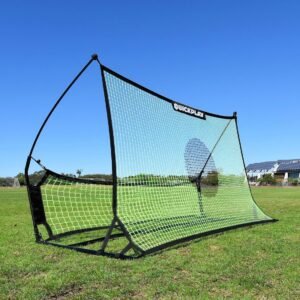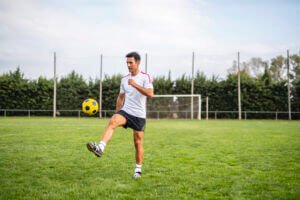
Without adequate speed, players may find themselves lagging behind the competition, missing out on scoring opportunities, and struggling to keep up with the fast-paced nature of the game.
In this comprehensive guide, we’ll delve into the various facets of speed improvement in soccer and provide actionable tips and insights to help players of all levels boost their speed and agility on the field.
Table of Contents
Understanding Speed in Soccer:
What is Speed?
In soccer, speed refers to the ability to move quickly across the field, both with and without the ball. It encompasses various elements, including acceleration, top speed, agility, and reaction time.
Types of Speed:
- Linear Speed: The ability to sprint in a straight line.
- Agility: The capacity to change direction quickly and efficiently.
- Acceleration: The ability to reach top speed rapidly from a standing or slow-moving position.
Understanding these different types of speeds is crucial for effective training and performance on the field.
Training Techniques for Speed Improvement:
Dynamic Warm-Up:
Before engaging in any speed training, it’s essential to properly warm up the body to prevent injuries and optimize performance. A dynamic warm-up routine should include exercises that activate the muscles and prepare them for the demands of sprinting and agility drills.
Sprint Training:
Incorporating sprint drills into your training regimen is key to improving acceleration and top speed. Focus on short bursts of maximum effort, with adequate rest between repetitions to maintain quality.
Strength Training:
Strength training plays a vital role in enhancing speed and power on the soccer field. Exercises such as squats, deadlifts, lunges, and plyometrics help develop the explosive strength needed for sprinting and agility.
Plyometric Exercises:
Plyometric drills are designed to improve explosive power and agility. Exercises like box jumps, bounding, and ladder drills help athletes develop the ability to generate force quickly and efficiently, crucial for speed in soccer.
Nutrition and Recovery for Speed Enhancement:
Hydration:
Staying hydrated is essential for optimal performance on the field. Dehydration can lead to decreased energy levels and impaired cognitive function, affecting speed and agility.
Nutrition:
Fueling your body with the right nutrients is crucial for energy production, muscle repair, and recovery. Focus on consuming a balanced diet rich in lean protein, complex carbohydrates, and healthy fats to support your training goals.
Rest and Recovery:
Proper rest and recovery are just as important as training itself when it comes to improving speed in soccer. Aim for 7-9 hours of sleep per night and incorporate rest days into your training schedule to allow your muscles to repair and grow.
Remember, speed in soccer is not just about raw sprinting ability; it’s about the ability to accelerate, decelerate, change direction, and maintain high speeds over the course of a match.
Action Plan:
Dynamic Warm-Up: Prioritize a 10-15 minute dynamic warm-up before each training session.
Sprint Training: Incorporate 2-3 sprint sessions per week, focusing on short, intense efforts.
Strength Training: Include 2-3 strength training sessions per week, targeting major muscle groups with compound exercises.
Plyometric Exercises: Integrate plyometric drills 1-2 times per week to improve explosiveness and agility.
Nutrition and Recovery: Maintain a balanced diet, stay hydrated, and prioritize rest and recovery strategies to support your speed training efforts.
FAQ Section:
Is there a specific program I can follow that’s guaranteed to produce results?
Yes, if you want to follow a proven program that has everything you need to increase your speed and athleticism, then try out Shea Pierre’s programs.
How long does it take to see speed improvements?
The timeline for seeing improvements in speed varies depending on various factors such as individual genetics, current fitness level, and the consistency of training. With a dedicated and structured training program, many athletes start to notice improvements in speed within a few weeks to a couple of months.
Can anyone improve their speed, or is it mostly genetic?
While genetics can play a role in determining an individual’s baseline speed potential, almost anyone can improve their speed with the right training and dedication. Speed is a trainable attribute that can be enhanced through specific drills, exercises, and proper technique.
Are there specific drills for improving agility on the soccer field?
Yes, there are several drills specifically designed to improve agility on the soccer field. Some examples include ladder drills, cone drills, shuttle runs, and agility ladder exercises. These drills focus on improving footwork, change of direction, and body control, essential for agility in soccer.
Should I focus more on speed or endurance training for soccer?
Both speed and endurance are important components of soccer performance, and a well-rounded training program should include elements of both. However, the emphasis may vary depending on the player’s position and playing style. Speed training is crucial for explosive bursts of acceleration and top-speed sprints, while endurance training helps players maintain performance levels throughout the duration of a match.
Conclusion:
In conclusion, speed is a fundamental aspect of soccer that can significantly impact performance on the field. By understanding the different types of speed, incorporating effective training techniques, prioritizing nutrition and recovery, and seeking expert guidance, players can enhance their speed and agility to elevate their game to the next level. Remember, consistency and dedication are key to achieving your speed improvement goals. So lace up your cleats, hit the field, and unleash your full-speed potential!



